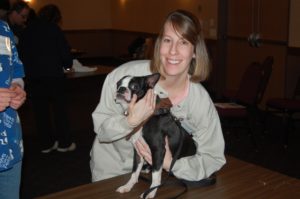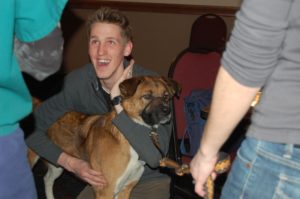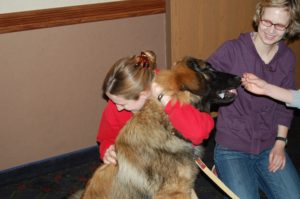Madison, Wisconsin, April 25, 2009. It’s a quiet, gray day outside in Madison, Wisconsin, but inside, the room’s abuzz. Fifteen dogs of various sizes are being handled by veterinarians and veterinary students in the Happy Pets, Happy Vets behavior and low stress handling workshop. The workshop, organized by the Behavior Club at the School of Veterinary Medicine, University of Wisconsin is my first symposium in Wisconsin. The event, consisting of a full-day lecture and half-day lab is so popular that it has to be held at a larger venue, an off-sight hotel. And a number of lecture participants are wait-listed for the labs. The lab covers low stress handling techniques on both dogs and cats.
Whether it’s working on a “C-hold,” sliding dogs from a standing to lateral position, or performing a half-burrito or modified scarf wrap on a cat, participants are finding there is more technique than meets the eye. Get a calm, quiet dog or cat and it all seems great but get one that squirms and you know immediately that you must be doing it wrong.
And when participants proclaim, “I feel like I’m strangling the dog with the C-hold,” or, “it doesn’t feel right,” it means their technique is not correct. Once they make a slight adjustment they feel a huge difference. Says one participant, “I was having trouble getting one dog from the standing position onto her side and I thought it was just that I wasn’t strong enough. Then when I did it right, I realized that is was just my technique.”
You might think that the techniques are ones that only veterinary students need to learn, but across the board, seasoned veterinarians, technicians, and veterinary students make the same types and number of mistakes. Says one veterinarian, “We didn’t get this type of handling class when I was a student and we need it so much. It needs to be taught at every veterinary school.”
Another participant agrees, “We weren’t taught good handling techniques in school. Practical experience teaches you but it doesn’t necessarily teach the “right” way.”
One participant, Kathleen Primozich, states, “I came to the workshop to learn how to handle cats. I’m not comfortable handling them in the clinic. The toweling techniques we learned were great.”
Toweling wasn’t just about throwing a towel loosely over a cat. Participants learned 8 specific towel wraps and how to wrap them snugly to help keep cats comfortable and calm. They first practiced on stuffed cats. Then some practiced on live cats too.
Liv Kismartoni, the Behavior Club Co-president and symposium organizer, states, “Students really want and need and are looking for better ways of handling the animals. It’s scary going into fourth year. You have education and medical stuff and framework from which to look at medicine but you don’t have the tools to work with the patients. Clearly they need it since a student got bitten last week in surgery lab.”
For veterinarians, there’s an added benefit.
Liv explains, “It’s difficult to change a paradigm at a hospital just because you think it’s the right way to do it. You can’t tell co-workers ‘you’re handling that animal too aggressively, maybe you should try it this way instead.’ They won’t believe you. Being able to go to a seminar with a credible person makes a huge difference. Now you can go home with the book and DVD and say ‘Hey why don’t you try this?’ You can show them and demonstrate it. It’s a lot easier to talk to your staff and get them to change to safer, less stressful techniques when you have a credible source.”






